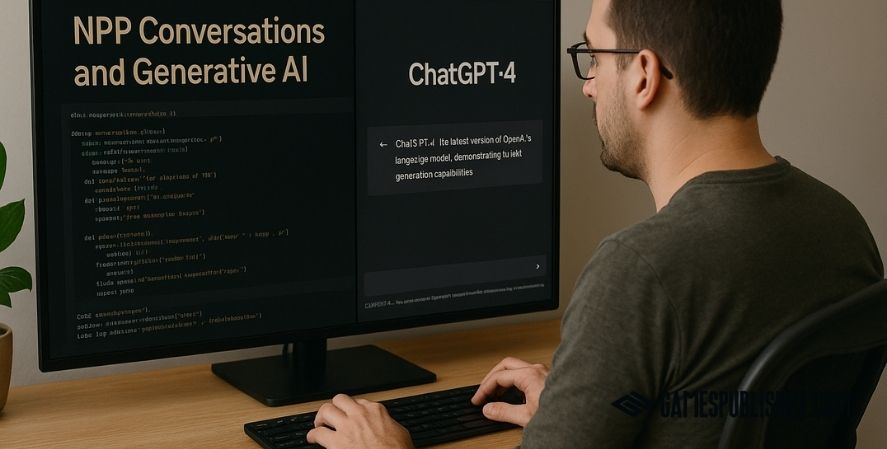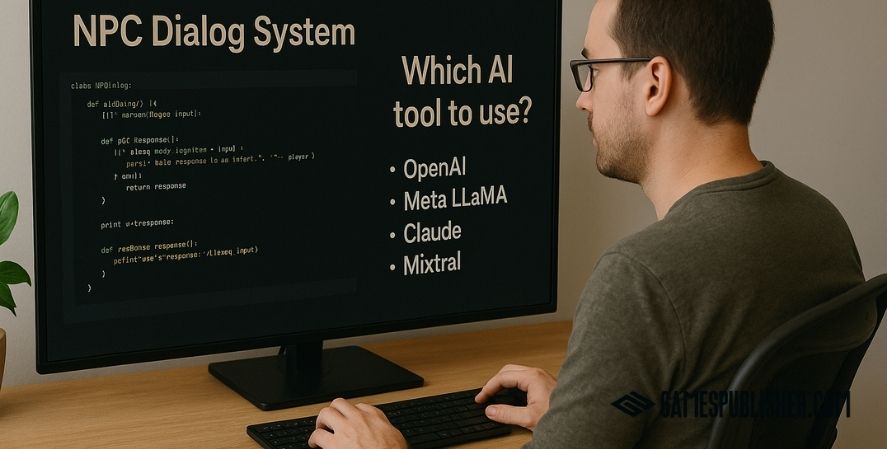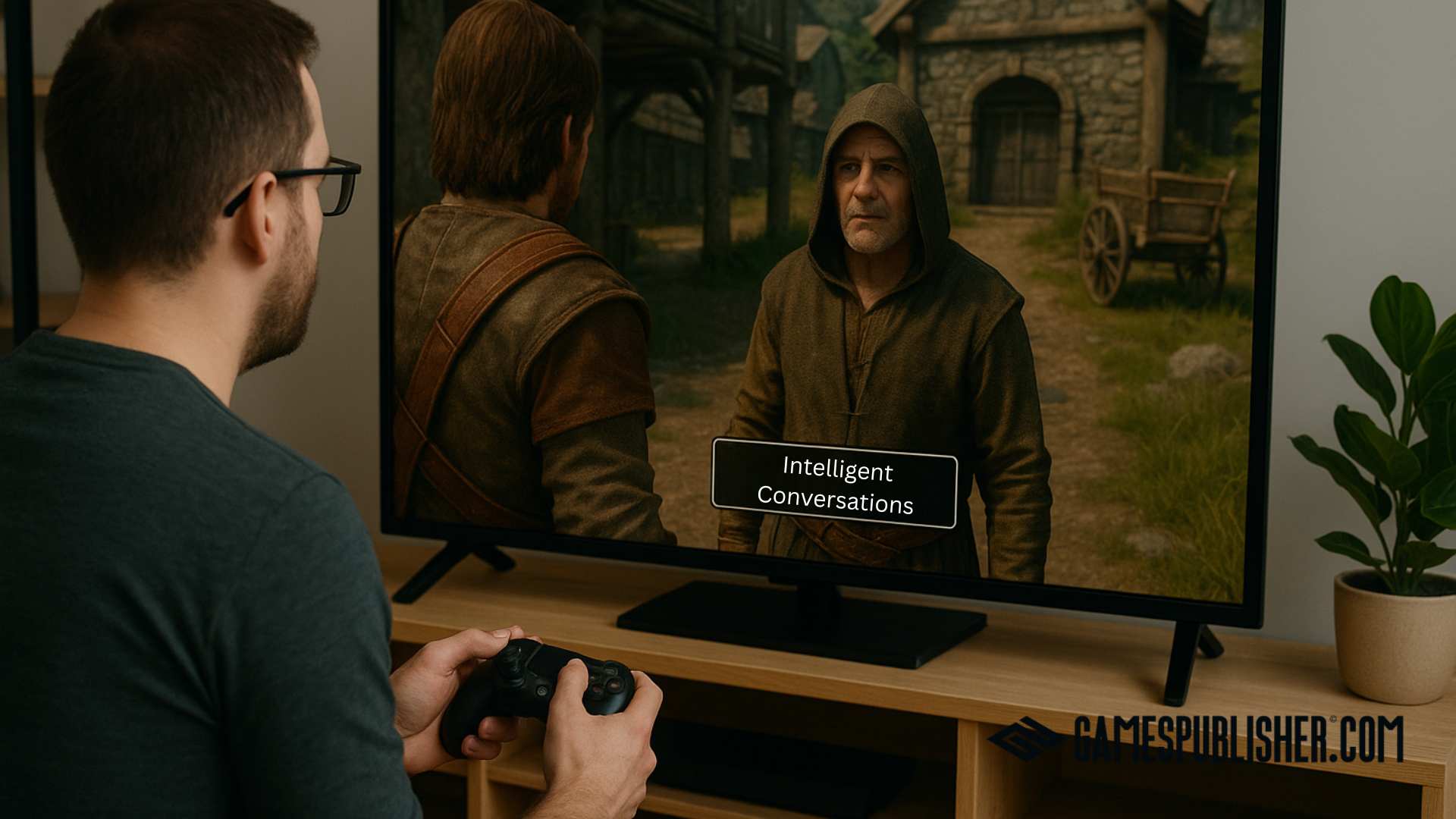In 2025, AI NPC technology is transforming how characters behave and interact in video games. These Artificial Intelligence Non-Player Characters are no longer limited to basic scripted responses. Instead, they are becoming intelligent, emotional, and reactive entities that enhance storytelling, improve immersion, and save developers countless hours in scripting dialogue.
At Gamespublisher.com, we analyze the technologies and trends that shape the future of gaming. Among the most impactful tools today are AI NPC dialogue engines, which help create more believable and responsive characters. These tools play a vital role in shaping how players experience narratives in games.
But what are the key technologies behind these systems? Which platforms should developers use? And what are the challenges and best practices for bringing AI NPCs into your next game?
Let’s explore how AI NPC tools are evolving, what benefits they offer, and how developers are integrating them into next-gen games in 2025.
AI NPC Technology and How It Has Evolved
From Scripted Lines to Intelligent Conversations
Early video games relied on hardcoded scripts and limited dialogue trees. For years, non-player characters simply responded with a set of pre-written phrases. Players had to choose from fixed options, often repeating the same lines over and over.
However, as game development evolved, developers began exploring more dynamic approaches. A significant milestone was the release of Bethesda’s Radiant AI, which allowed characters to perform goal-based actions and routines. Even though dialogue was still mostly scripted, NPCs began to feel more autonomous.
In recent years, the use of generative AI in video games has taken this concept further. With language models like GPT-4, NPCs can now engage in fluid conversations. They are no longer tied to rigid scripting. Instead, they can respond intelligently to player questions, adapt their tone, and even reference past interactions.

For example, in modern ai npc games, players can ask questions outside the preset choices, and characters can respond accurately in context. This flexibility significantly increases immersion and makes each interaction feel more natural.
Moreover, the shift from prewritten lines to AI NPC generators opens up new creative possibilities for game developers. Conversations can now be generated in real time, allowing NPCs to speak in ways that feel human, reactive, and emotionally rich.
The Role of Machine Learning and NLP in AI NPC Development
The development of realistic AI NPC behavior would not be possible without advances in Natural Language Processing (NLP) and Machine Learning. These technologies allow NPCs to understand human language, interpret emotional cues, and remember prior interactions.
By using large language models (LLMs), such as GPT, LLaMA, or Claude, developers can create characters that not only speak convincingly but also think and react. These models have been trained on vast amounts of conversational data, enabling them to mimic human dialogue patterns.
For instance, when a player expresses frustration or sarcasm, the AI can interpret the tone and respond appropriately. This makes the interaction feel more believable, which is crucial for player immersion.
Additionally, NLP allows for better memory handling. An AI NPC can remember that the player previously completed a quest or made a certain decision. It can refer to this in future conversations, creating a sense of continuity and emotional investment.
This approach has become central to generative AI in game development, where AI models are trained or fine-tuned with specific lore, character personalities, and thematic rules to stay consistent within the game world.
AI NPC Dialogue Engines: Key Components and Tools
Dialogue Generation Models

At the heart of every AI NPC system is a dialogue model. These models are responsible for generating responses based on player input. The most common models in 2025 include:
- OpenAI’s GPT-4 and GPT-4o: These are among the most advanced models available. They provide deep contextual understanding, emotional awareness, and creative flexibility. Many developers choose them for their reliability and natural conversation style.
- Meta’s LLaMA 3: An open-source alternative that gives developers more control over model behavior. LLaMA is popular in games that need lightweight or customized implementations.
- Claude by Anthropic: Focused on safe and ethical AI generation. This model is often used in family-friendly or sensitive game genres.
- Mixtral and Mistral Models: These models prioritize performance and are suitable for real-time or on-device processing. They are commonly used in indie games or mobile applications.
These models function as the brains of ai npc generators, taking user input and producing relevant and immersive responses. Developers can train these models with character backstories, dialogue styles, and tone rules to match their specific game.
Emotion and Context Handling in AI NPC Systems
One of the most exciting advances in AI NPC systems is their ability to recognize emotion and remember context.
For example, if a player is aggressive in dialogue, the AI NPC may become defensive or nervous. If the player is friendly, the NPC may become more open and share personal stories.
This dynamic is achieved through several features:
- Sentiment Analysis: Detects whether player input is positive, negative, or neutral.
- Memory Systems: Stores past interactions so that NPCs can refer back to previous events.
- Emotional Modeling: Assigns emotional states to NPCs that influence how they respond over time.
These features are essential for building a trustworthy ai dialogue engine, especially in narrative-driven titles or emotional story arcs. Players often build relationships with characters over dozens of hours, and consistent emotional behavior strengthens those bonds.
Popular AI NPC Dialogue Engines in 2025
Several platforms lead the field in 2025, offering advanced capabilities for real-time conversation, emotional depth, and easy integration into existing game engines.
- Offers tools for creating fully autonomous, emotionally aware characters.
- Supports memory, goals, and long-term character development.
- Compatible with Unity, Unreal, and proprietary engines.
- Ideal for large narrative RPGs and open-world ai games.
- Focused on real-time voice interaction with NPCs.
- Emphasizes emotional detection and context retention.
- Provides plugins for Unreal Engine, VR, and multiplayer games.
- Popular in action games and VR storytelling experiences.
- Designed for interactive storytelling and character arcs.
- Allows for branching dialogue, emotion tracking, and cinematic delivery.
- Suitable for both mobile games and AAA-level productions.
- Often used by video game publishers seeking immersive story mechanics.
- An open-source option that combines rule-based logic with machine learning.
- Highly customizable for developers who want granular control.
- Best suited for structured NPC behavior with AI flexibility.
- Common in hybrid dialogue systems or educational ai generated games.
These tools are evolving fast, giving game developers multiple options based on their platform, budget, and game genre. Whether you’re working on a dialogue-heavy indie project or a sprawling MMO, there’s an AI NPC tool that can fit your development workflow.
Benefits of AI NPC Dialogue Systems in Game Development
Enhanced Player Immersion
One of the main reasons to use AI NPCs is to boost immersion. Traditional NPCs often feel lifeless because they repeat the same lines or act unnaturally. In contrast, AI NPC characters can react to player behavior, make jokes, show empathy, or even develop relationships.
This makes players feel like they are part of a living world, not just interacting with game scripts. In genres like RPG, survival, or exploration, these interactions can make the difference between a good game and a great one.
Moreover, ai npc games that use dynamic dialogue often receive praise from both players and critics for storytelling innovation.
Reduced Development Workload

Scripting thousands of unique dialogue interactions is time-consuming. Writers must consider all player paths, choices, and tones. However, with ai npc generators, much of this work can be automated.
For example, instead of writing ten variations of a conversation, a developer can prompt the AI to generate them based on context. This lets writers focus on the story, tone, and world-building, while the AI handles repetition and branching.
This benefit is especially valuable for game developers working with small teams or tight deadlines.
Personalization and Replayability
Because AI NPC systems can adapt to each player’s choices, no two playthroughs are the same. One player might befriend an NPC, while another might insult them, leading to different outcomes.
This level of personalization increases replay value, especially in narrative-driven games. Players are more likely to return to a game if they know their next experience could be completely different.
This trend is aligned with current game publishing strategies that focus on long-term player engagement and player-driven storytelling.
Challenges and Limitations of AI NPC Dialogue
As promising as AI NPCs are, there are still limitations that game developers must consider. These challenges affect both performance and the overall quality of the game experience. Understanding them early can help teams make better decisions when integrating these systems.
Risk of Repetitive or Generic Responses
Although large language models are powerful, they can sometimes produce answers that feel overly formal or repetitive. This problem becomes more noticeable in games where players interact with NPCs frequently.
For instance, if a model isn’t fine-tuned correctly or lacks specific training data, it may resort to vague replies. This can break immersion, especially in high-detail ai npc games where every line matters.
To prevent this, developers must spend time refining prompts, adjusting personality weights, and reviewing generated responses. More importantly, including fallback dialogue or rules can ensure that conversations remain engaging even when AI fails to produce the perfect line.
Ethical and Content Moderation Concerns
Another key concern is ensuring that the AI-generated content stays appropriate. Since LLMs are trained on massive datasets, there’s always a chance that an AI NPC might generate an offensive, politically sensitive, or inappropriate comment if not properly filtered.
This is particularly risky for video game publishers whose games reach global audiences, including children and teens.

To address this, developers can use moderation filters or rules-based models in combination with generative systems. Some teams also add manual review processes for critical dialogue paths or restrict AI to certain types of conversations.
Establishing a trustworthy ai dialogue engine is essential for maintaining the studio’s reputation and complying with global content standards.
Technical and Performance Constraints
Real-time AI generation can be demanding on system resources. Using advanced models like GPT-4 in a live game requires either strong local hardware or a reliable cloud connection.
This introduces a few trade-offs:
- Cloud-based AI can reduce processing requirements but may cause latency during gameplay. This affects player experience, especially in fast-paced games.
- On-device AI offers better performance but often needs optimized, smaller models like Mistral or LLaMA, which may reduce dialogue quality.
Choosing between these options depends on the game’s target platform and performance goals. For example, large open-world games might benefit from hybrid systems, where critical dialogue is pre-generated and side conversations use live AI generation.
AI NPC Integration in Game Engines
Most modern games are built using engines like Unity or Unreal, which offer robust tools and plugin support for AI features. As a result, integrating AI NPCs has become more straightforward in 2025.
Unity and Unreal Engine AI NPC Plugins
Both Unity and Unreal now support native or third-party plugins that enable real-time AI integration.
In Unity:
- Inworld AI SDK for Unity allows developers to create characters with emotional states, memory, and conversation goals.
- Charisma.ai Unity plugin offers storytelling tools with mood tracking and dynamic branching systems.
- Lightweight AI models like Rasa can be embedded directly into Unity for offline processing.
In Unreal:
- Convai Unreal Plugin is a favorite among studios working on high-fidelity environments and VR games.
- It supports real-time voice input, context memory, and non-verbal reactions such as expressions and gestures.
- Developers can also integrate external APIs for custom language models or sentiment tracking.
With these tools, developers can build complex AI NPCs without having to reinvent core systems, saving time and reducing integration risks.
Cloud vs On-Device Deployment of AI NPCs
Choosing how to deploy your ai npc generator is a critical decision. The performance, cost, and user experience will depend heavily on where the AI runs.
Cloud Deployment:
- Offers access to powerful models like GPT-4 and Claude
- Easier to scale across multiple users
- Requires internet connection and consistent bandwidth
- Often charged based on API usage
On-Device Deployment:
- Reduces latency and removes dependency on external servers
- Enhances privacy for players and studio alike
- Limited by device capabilities, especially on mobile and consoles
- Requires optimized or distilled models to maintain speed
Many developers now adopt a hybrid model. Important story beats are generated in advance and stored locally, while side dialogues or sandbox conversations use real-time generation through the cloud.
This setup ensures performance without sacrificing depth.
Custom Training for AI NPC Personalities
While prebuilt models are powerful, custom fine-tuning takes them even further. By training the AI with character-specific information, developers can ensure that each NPC has a unique personality, tone, and memory.
For example, an elven scholar in a fantasy game might:
- Use formal and archaic language
- Reference historical events from the game’s lore
- Show emotional restraint unless provoked
Fine-tuning models using tools like Inworld Studio or Hugging Face transforms generic outputs into character-specific lines that align perfectly with the game’s world.
Custom personalities are essential for:
- Narrative-driven RPGs
- Open-world games with complex factions
- Interactive fiction or dating sims
Ultimately, this level of control allows game developers to create deeper, more memorable characters that feel fully alive.
Future Trends of AI NPC Development
Looking ahead, the future of AI NPCs promises even more realism, player agency, and creative possibilities. Let’s explore what’s coming next.
Multimodal AI NPCs (Voice, Gesture, Emotion)

In 2025, the line between visual and conversational interaction is fading. AI NPCs are now using multimodal systems, which combine:
- Natural voice generation
- Facial animations and gestures
- Emotion-aware reactions
For example, when a player shouts during a VR game, the NPC might flinch, raise their hands, or change their expression to fear. All of this happens in real time using voice tone analysis and character animation pipelines.
This trend is growing rapidly, especially in VR, AR, and cinematic games. Tools like Convai and Charisma.ai already support emotional awareness and are expanding to include motion-driven feedback.
AI NPCs in Open World and Sandbox Games
AI NPCs thrive in open-world environments. These are the types of games where character autonomy is most noticeable.
Rather than following fixed routes, NPCs can now:
- Make decisions based on the environment
- React to player actions without scripts
- Hold conversations with other NPCs
- Change relationships dynamically
This evolution supports the vision of ai generated game worlds, where systems govern character behavior instead of static code. Developers can build self-sustaining societies, with emergent storytelling driven by NPC interactions.
Community-Generated AI NPC Content
One of the most exciting developments is the rise of user-created NPCs powered by AI.
Modding communities are already:
- Designing their own AI characters
- Uploading them to Steam Workshop or Nexus Mods
- Sharing backstories, voice profiles, and dialogue behaviors
These user-generated NPCs allow games to stay fresh long after launch. They also give players a sense of ownership, encouraging more experimentation and personalization.
This trend is shaping the next generation of ai generated games, where player-driven content blends seamlessly with developer tools.
Conclusion
AI NPCs are no longer a futuristic idea. They are a practical, accessible, and powerful feature of modern game development in 2025.
From scripted beginnings to emotionally intelligent characters, AI has opened the door to new levels of immersion, personalization, and creativity. With platforms like Inworld AI, Convai, Charisma.ai, and Rasa, developers now have a wide range of tools to create lifelike characters who respond, remember, and evolve.
Whether you’re a solo game developer, a AAA studio, or part of an indie team, these tools can elevate your projects and help you stand out in a crowded market.
As the industry continues to explore generative AI in games, the next step is clear. Embrace the tools, learn the techniques, and start building AI NPC experiences that captivate and surprise your players.
The future of ai npc games is not just about smarter characters. It’s about deeper worlds, stronger stories, and unforgettable player journeys.
Now is the time to experiment, iterate, and innovate.
Loading survey...

